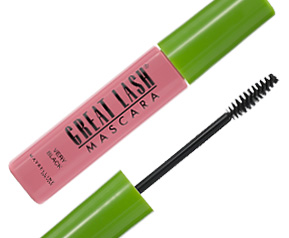The section on the eyes begins with explaining the importance of the eyes as communication tools, and how they were accentuated with various colors, styles, and trends over time. The most common since the beginning was the use of kohl. Used either as mascara or eyeliner, it was compiled out of a variety of ingredients such as lead, donkey liver, crocodile dung, malachite, galena copper, and iron manganese. Lampblack, the ashes from a candle were also turned into inexpensive kohl. Ground up and mixed with grease, the makeup was applied with fine sticks, and stored in small containers or shells.

During the 19th century, fair hair was considered a birth defect and women with light hair darkened their eyebrows and lashes with dye made of walnut hulls. When the readily available commercial cosmetics began to outnumber the use of homemade cosmetics, the early 20th century saw a change in how paint for the eyes became acceptable.
1910 saw a shift from home production of cosmetics to commercially manufactured production. A 1909 performance of the London Ballet featured the use of heavy eye shadows ans mascara, and spurred the brisk sale of these products. The upper classes favored kohl on the eyes, and eye shadow colors weer coordinated to match clothing. Gold and silver eye shadows were also introduced to use with evening wear. (Hernandez, 48)
After the first World War, mascaro, a hair dye product for men was re-branded as mascara and promoted as a darkener for eyelashes. Sold in either blocks or in crayon-like tubes, it was a waxy substance melted over flame, applied to lashes, and removed with cold cream. Silent film actresses such as Theda Bara and Clara Bow adopted the look for screen and off-screen, and it revolutionized the way the world saw eye makeup.

An eyelash curler named Kurlash was invented in 1923. Readily available and easy to use nowadays, eyelash curlers are often taken for granted. Kurlash was expensive to purchase and curling each lash-line could take up to 10 minutes.
Another invention of the 1920's was the eyebrow pencil;
The eyebrow pencil of the 1920's rose to popularity after it was improved with a new formula consisting of hydrogenated cottonseed oil. The new ingredient made the texture and its application softer and also prevented the spread of harmful bacteria. (52)
The blackened eyes of the flapper eventually fell out of fashion, and 1930s glamor icons like Greta Garbo brought in new make up trends with red lips and mascaraed eyes. Unlike Max Factor who created a wax crayon of mascara, Mabel T. L. Williams, the founder of Maybelline created it in cake form, which was readily available to the public by the 1930's.
Mascara became instilled in the beauty routines of women throughout the 1930's, and was available in cake form, crayon form, and cream form (dyed Vaseline). All forms of mascara during this period were applied with a small bristled brush. Popular brands available at the time were Max Factor (initially for film, and eventually for public consumption), Maybelline, Lash-Kote, Tattoo, Laleek Longlash, and Dorothy Gray.

The original idea for a mascara bottle was invented by Frank L. Engel Jr. in 1939, however he never received money for his patent. The liquid mascara that was popularized on the market in 1958 was Helena Rubinstein's 'MascaraMatic'. It came in a tube similar to modern mascara, and the end of the wand had a metal tip with grooves to hold product and apply to lashes. Liquid eyeliner also became available in the 1950's, because of experimentation with solvents that sped up drying time.
Still incredibly popular today, the pink and green tubes of Great Lash mascara were invented in 1971. Clear mascara was produced in 1988 by Max Factor, and during the 1990's colors, formulas, and textured were experimented with in order to create length, volume, growth, curl, and waterproof eyelashes.

False eyelashes, which were invented in 1916 by an American Film Director D.W. Griffith, were now available in many colors, with feather attachments, and crystals. Eyeshadow came in many forms of pencil, cream, and powder forms, with additional abilities to stay put all day.
Mascara brushes went from metal, to wire or plastic bristle, to silicone brushes which could hold more product and evenly distribute it as it built up layers. Formulas have changed to promote the growth of healthy lashes, and the introduction of elastic polymer to mascara preventing the breaking and flaking of traditional mascaras.
The future of eye make-up has brought a closer fusion of fashion with science, giving consumers beautiful colors while promoting healthy eyes and lashes. (63)
Works cited:
Hernandez, Gabriela. Classic Beauty, The History Of Makeup. Atglen, PA: Schiffer Publishing Ltd, 2013. Print.
The blog provided by you is very nice and it is very helpful to know the more information.keep update with your blogs .
ReplyDeletemakeup in vizag
best makeup in vizag
makeup artists in vizag
makeup studio in vizag
The blog provided by you is very nice and it is very helpful to know the more information.keep update with your blogs .
ReplyDeletemakeup in vizag
best makeup in vizag
makeup artists in vizag
makeup studio in vizag